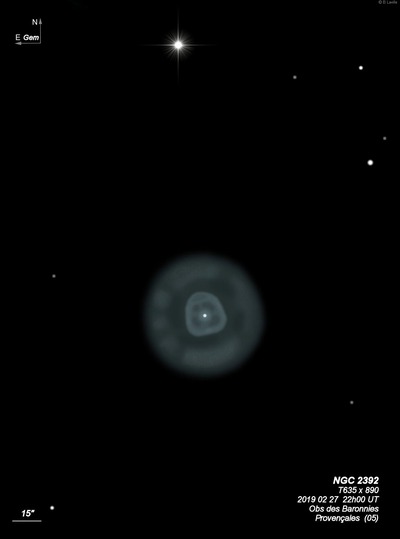Eskimo Nebula
Eskimo Nebula

William Herschel discovered NGC 2392 = H IV-45 = h450 on 17 Jan 1787 (sweep 694) and recorded "a star with a pretty strong milky nebulosity equally dispersed all around. The star about 9m. Having but just began I suspected the glass to be covered with damp, or my eye not yet to be in order; however a star 10 or 11m just north of it was free from the same appearance. A very curious phenomenon; like my northern Planetary in its growing state." The next night he added "One of the most remarkable phenomena I ever have seen." In the 1814 PT paper he used this object as an example of an evident connection between an atmosphere and a star.
The annularity of NGC 2392 was discovered by George Johnstone Stoney, Lord Rosse's assistant, on 20 Feb 1849. Stoney's sketch (figure 15, plate XXXVIII in the 1850 PT paper) also shows a dark spot just to the right (west?) of the central star. William Lassell reported similar structure with his 24-inch in Jan 1853: "The nebulous star has its envelope evidently fainter on the preceding side. Its circular outline is almost wanting there. About half-way between the centre and circumference there is a narrow, concentric, dark ring, within which the nebula is brighter than the exterior portion." His sketch was published in his 1854 MRAS paper (figure 6) on observations from Malta.
Using an 18.2-inch silvered-glass reflector Henry Cooper Key reported, "the present appearance of this object, as seen in my instrument, is that of a bright, but somewhat nebulous star closely surrounded by a dark ring; this again by a luminous ring; then an interval much less luminous, and, finally, at some distance, an exterior luminous ring" (1867MNRAS..28....2A). Father Secchi also sketched the double ring structure with the 9.5" refractor in Rome around 1856 as well as Barnard with the 12-inch refractor at Lick Observatory on 10 Apr 1890. He reported "a condensed point or 2 in the preceding part [of the inner disc], then there seems to be a dark vacuity about this disc and then a fainter nebulous ring. It is a remarkable object."
The CGCG misidentifies CGCG 086-035 = PGC 21128 as NGC 2392. The nickname "Eskimo Nebula" dates back to at least 1962 in a paper by William Liller's titled "Expansions of Planetary Nebulae".
300/350mm - 13.1" (1/28/84): bright mag 9 central star surrounded by a double shell with a bright inner disk and a dark ring separates the two shells.
400/500mm - 17.5" (12/19/87): using 410x exhibits a prominent double shell structure with a very bright inner shell about 20" diameter with a darker central hole surrounding a very bright mag 9 central star. The Eskimo has a very high surface brightness with a bluish color and easily takes this magnification. The inner shell is surrounded by a thin dark ring about 2/3 of the way out from center and a faint, barely detached outer halo. Located 1.6' S of mag 8.3 SAO 79428.
900/1200mm - 48" (4/1/11): I just took a quick look at the Eskimo at 488x but the view of the double green shells was stunning. The inner, brilliant annulus is irregularly shaped, with an elongated bulge on the north side. The ring essentially splits into two sections at the north end (the inner "ring" is fainter) with a darker interior forming a small pouch within the ring. This feature could be considered the "chin" at the bottom of the Eskimo's "face" in the eyepiece view. The outer shell is irregularly lit and brighter along the southern rim.
Notes by Steve Gottlieb